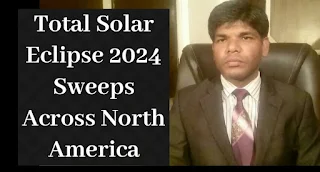Total Solar Eclipse 2024 Sweeps Across North America
It's the day that has astronomy enthusiasts and sky gazers alike eagerly anticipating: the total solar eclipse of 2024 has finally arrived.
Today, on April 8th, a mesmerizing celestial event will unfold as a total solar eclipse makes its way across North America, spanning from Mexico through 15 U.S. states and up into Canada. For those fortunate enough to be within the path of totality, the moon will completely obscure the sun, plunging the sky into darkness and revealing the sun's ethereal outer atmosphere.
To stay updated on the latest eclipse developments, enthusiasts can follow along with live coverage on our eclipse live blog and witness the celestial spectacle unfold courtesy of NASA's livestream, beginning at 1 p.m. EDT (1700 GMT).
While every U.S. state will witness at least a partial solar eclipse, individuals can determine the timing and appearance of the eclipse from their specific location using NASA's interactive map.
A total solar eclipse occurs when the moon aligns perfectly between the sun and Earth, casting a shadow on our planet. Its apparent size closely matches that of the sun, and for those within the path of totality, the moon will entirely obscure the sun's visible disk.
For those who may have procrastinated in acquiring eclipse glasses, alternative methods for safely viewing the eclipse using household items are available. However, it's crucial to emphasize never to look directly at the sun without proper protection. Solar glasses or filters are imperative for safely observing the eclipse, with only those within the path of totality permitted to briefly remove them to view the sun's corona with the naked eye.
During the partial phases of the eclipse, and for those outside the path of totality, solar eclipse glasses are essential. Additionally, cameras, telescopes, and binoculars must be equipped with solar filters to prevent damage to the eyes and equipment.
For comprehensive guidance on safely observing the sun, our "how to observe the sun safely" guide offers essential information for enjoying this celestial phenomenon without risking eye damage.
As the total solar eclipse of 2024 captivates audiences across North America, let us marvel at the wonders of our universe and cherish the rare spectacle unfolding before our eyes.
Title: "Eclipsemania: A Guide to Monday's Solar Eclipse Phenomenon in the Tri-State Area"
As the anticipation builds, 'eclipsemania' has swept over the tri-state area in preparation for Monday's extraordinary celestial event – a total solar eclipse. On April 8, 2024, the moon will gracefully maneuver in front of the sun, obscuring it either partially or entirely, casting awe-inspiring shadows across the landscape.
While New York City may not find itself in the direct path of totality, residents can still expect to witness a remarkable partial eclipse, with approximately 89 percent coverage. However, areas further north, such as the Capital Region, will experience an impressive 96 percent coverage, while upstate New York, including cities like Buffalo, Rochester, and Plattsburgh, will be treated to the breathtaking spectacle of total coverage for up to four minutes.
The countdown to this celestial marvel is nearly complete, marking one of the most exhilarating astronomical events. As the moon gracefully traverses its path in front of the sun, daylight will momentarily fade into an enchanting twilight.
Notably, the last total solar eclipse graced the skies on August 21, 2017, leaving enthusiasts eagerly awaiting the next opportunity to witness this rare phenomenon.
For New York City residents, the eclipse experience will commence shortly after 2 p.m. on Monday, offering a captivating display of nature's grandeur. However, the true spectacle awaits those situated in the western and northern regions of New York State.
In a brief yet captivating window between 3:15 p.m. and 3:30 p.m., communities within a 100-mile-wide path of totality will be enveloped in an ethereal darkness, lasting anywhere from 1 ½ to 3 ½ minutes. Cities such as Jamestown, Buffalo, Rochester, Syracuse, Watertown, Old Forge, Lake Placid, and Plattsburgh will be immersed in this extraordinary event, as the moon's shadow dances across the landscape.
For observers outside the path of totality, the celestial show promises to be no less spectacular. Even in areas like Long Island, where coverage reaches a minimum of 88 percent, and New York City, with an anticipated 89 percent coverage, the eclipse will still dazzle spectators with its celestial ballet.
Storm Team 4 forecasts the partial eclipse in New York City to begin around 2 p.m., reaching its peak at approximately 3:25 p.m., and concluding around 4:36 p.m., providing ample opportunities for enthusiasts to witness this astronomical marvel.
As the tri-state area eagerly awaits the arrival of this celestial spectacle, let us marvel at the wonders of the cosmos and embrace the magic of the solar eclipse unfolding before our eyes.









0 Comments